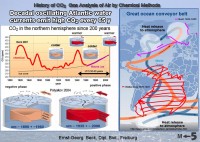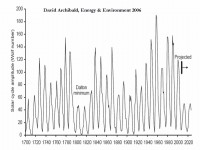
|
May 20, 2007
Sun of a Gun
By Licia Corbella, the Calgary Sun
It was an e-mail from a fella named Gerald in the Niagara region, that indicates just how good a job the man-made global warming believers have been at selling their message. “If humans are not the cause of global warming ... who is?” Gerald wrote. My response was: “Gee, Gerald. Can you really not think of anything? Nothing at all?” Then I suggested he find the nearest child and ask them what makes the earth warm. The next day I got a reply. “Do you mean the sun?” he queried, in all sincerity. “Yes, Gerald. That big, burning yellow ball up in the sky is, not surprisingly, the main driver of global warming.”
Yesterday, world renowned paleoclimatologist and geology professor at Carleton University in Ottawa, Dr. Tim Patterson, was in Calgary to pass that basic message on. He brought reams of proof, scientific studies, graphs and the like to back up his claims. Indeed, one of the more interesting, if not alarming statements Patterson is that by about the year 202, solar cycle 25 will be the weakest one since the Little Ice Age (that started in the 13th century and ended around 1860) a time when people living in London, England, used to walk on a frozen Thames River and food was scarcer.
“This should be a great strategic concern in Canada because nobody is farming north of us.” In other words, Canada—the great bread basket of the world—just might not be able to grow grains in much of the prairies. After the Little Ice Age, “things warmed up precipitously with no help from carbon dioxide,” pointed out Patterson. Indeed, the world warmed up until about 1940 and then the temperatures started to fall until the late 1970s when scientists started predicting another ice age. “Post World War II, as the world started cooling, CO2 was going up like crazy. All the evidence shows that warming periods were all solar driven and that there is no correlation between CO2 and temperature. That, however, is expected to come to an end in 2020.
As the saying goes, by then all of the billions of dollars wasted battling CO2 emissions, rather than pollutants, for instance, will be money pumped down the CO2 sink hole. In 2020 hindsight on the great global warming scare will be 20/20. It won’t be a pretty picture. See full story here
May 14, 2007
New findings indicate today’s greenhouse gas levels not unusual
By Dr. Tim Ball and Tom Harris, Canada Free Press, Toronto, Ontario
One of the fundamental pillars of the hypothesis that humanity is causing dangerous climate change is the belief that levels of carbon dioxide (CO2) have been rising steadily since the start of the industrial revolution. But what if CO2 levels have not increased? How could our emissions of this otherwise benign gas then have anything to do with the past century’s modest warming?
The most accurate way to determine the atmosphere’s average CO2 content is to simply conduct a direct chemical analysis at many different places and times. Fortunately, there are more than 90,000 direct measurements by chemical methods between 1857 and 1957. However, in what appears to be a case of ‘cherry-picking’ data to fit a pre-determined conclusion, only the lower level CO2 data were included when the pre-industrial average was calculated? This is the average that was used to supposedly ‘validate’ the long term ice core records on which Al Gore and others depend.
In a new scientific paper in the journal Energy and Environment, German researcher Ernst-Georg Beck, shows that the pre-industrial level is some 50 ppm higher than the level used by computer models that produce all future climate predictions. Completely at odds with the smoothly increasing levels found in the ice core records, Beck concludes, “Since 1812, the CO2 concentration in northern hemispheric air has fluctuated, exhibiting three high level maxima around 1825, 1857 and 1942, the latter showing more than 400 ppm.”
In a paper submitted to US Senate Committee hearings, Polish Professor Zbigniew Jaworowski, a veteran mountaineer who has excavated ice from 17 glaciers on six continents, stated bluntly, “The basis of most of the IPCC conclusions on anthropogenic [human] causes and on projections of climatic change is the assumption of low level of CO2 in the pre-industrial atmosphere. This assumption, based on glaciological studies, is false.” See full story here

Both Beck’s paper and Jarowoski’s testimony can be found in our Climate Library at Beck 2007 and Jarowoski 2004 US Senate Testimony. From what I have read from Beck and heard directly from Jarowoski and Segalstad in Europe, there is real reason to believe this other fundamental pillar of the whole AGW movement needs a fresh look much like the temperatures. We will be addressing both issues in upcoming blogs.
May 12, 2007
Solar Cylces 24 and 25 and Predicted Climate Response
David Archibald, Energy & Environment, 2006
The past solar cycle was 20% less than the two prior cycles. The current cycle is proving much longer than any in recent decades and longer cycles usually are associated with lowered solar activity. As we have indicated most projections for the next cycle(s) are for a continued decline (See Lund Forecasts Cycle 24). Quiet cycles historically have been associated with widespread global cooling.
David Archibold in Energy & Environment reports on what quiet cycles 24 and 25 might mean for temperatures. Here is the abstract.
Projections of weak solar maxima for solar cycles 24 and 25 are correlated with the terrestrial climate response to solar cycles over the last three hundred years, derived from a review of the literature. Based on solar maxima of approximately 50 for solar cycles 24 and 25, a global temperature decline of 1.5°C is predicted to 2020, equating to the experience of the Dalton Minimum.

For see full story on climatepolice.com link
May 10, 2007
Does The 2007 IPCC SPM Accurately Present Recent Global Temperatures?
Roger Peilke Sr., Climate Science Weblog
In a May 10, 2007 weblog posting Roger Pielke Sr. notes that the 2007 IPCC Statement for Policymakers (SPM) makes the following findings: (1) “Eleven of the last twelve years (1995 -2006) rank among the 12 warmest years in the instrumental record of global surface temperature (since 1850)” [based on “The average of near surface air temperature over land, and sea surface temperature.”]. and (2) “Warming of the climate system is unequivocal, as is now evident from observations of increases in global average air and ocean temperatures…”
This claim, which is repeated throughout the media reports on the IPCC report, however, is disingenuous. Other analyses of global heat system changes do not support the claim of continued warming of the climate system.
Rogers points out these include (1) since the middle of 2003, the upper ocean has not warmed (2) since about 2002, there has been NO statistically significant global average warming in the lower and middle troposphere and (3) since about 1995, there has been NO statistically significant cooling in the stratosphere. Each of trhese are in conflict with IPCC statements and model based projections.
See Roger’s full weblog here
May 06, 2007
The Faithful Heretic: A Wisconsin Icon Pursues Tough Questions
Wisconsin Energy Cooperative News, May 6, 2007
Reid A. Bryson holds the 30th PhD in Meteorology granted in the history of American education. Emeritus Professor and founding chairman of the University of Wisconsin Department of Meteorology. In the 1970s, he became the first director of what’s now the UW’s Gaylord Nelson Institute of Environmental Studies. He’s a member of the United Nations Global 500 Roll of Honor—created, the U.N. says, to recognize “outstanding achievements in the protection and improvement of the environment.” He has authored five books and more than 230 other publications and was identified by the British Institute of Geographers as the most frequently cited climatologist in the world.
Climate’s always been changing and it’s been changing rapidly at various times, and so something was making it change in the past,” he told us in an interview this past winter. “Before there were enough people to make any difference at all, two million years ago, nobody was changing the climate, yet the climate was changing.”
When asked if he would rank the factors the most significant impact and where would you put carbon dioxide on the list? Eighty percent of the heat radiated back from the surface is absorbed in the first 30 feet by water vapor. Eight hundredths of one percent ia absorbed by carbon dioxide. One one-thousandth as important as water vapor. You can go outside and spit and have the same effect as doubling carbon dioxide.
Bryson says he looks in the opposite direction, at past climate conditions, for clues to future climate behavior. Trying that approach in the weeks following our interview, Wisconsin Energy Cooperative News soon found six separate papers about Antarctic ice core studies, published in peer-reviewed scientific journals between 1999 and 2006. The ice core data allowed researchers to examine multiple climate changes reaching back over the past 650,000 years. All six studies found atmospheric carbon dioxide concentrations tracking closely with temperatures, but with CO2 lagging behind changes in temperature, rather than leading them. The time lag between temperatures moving up—or down—and carbon dioxide following ranged from a few hundred to a few thousand years. See full story here
Reid A. Bryson holds the 30th PhD in Meteorology granted in the history of American education. Emeritus Professor and founding chairman of the University of Wisconsin Department of Meteorology. In the 1970s, he became the first director of what’s now the UW’s Gaylord Nelson Institute of Environmental Studies. He’s a member of the United Nations Global 500 Roll of Honor—created, the U.N. says, to recognize “outstanding achievements in the protection and improvement of the environment.” He has authored five books and more than 230 other publications and was identified by the British Institute of Geographers as the most frequently cited climatologist in the world.
Climate’s always been changing and it’s been changing rapidly at various times, and so something was making it change in the past,” he told us in an interview this past winter. “Before there were enough people to make any difference at all, two million years ago, nobody was changing the climate, yet the climate was changing.”
When asked if he would rank the factors the most significant impact and where would you put carbon dioxide on the list? Eighty percent of the heat radiated back from the surface is absorbed in the first 30 feet by water vapor. Eight hundredths of one percent ia absorbed by carbon dioxide. One one-thousandth as important as water vapor. You can go outside and spit and have the same effect as doubling carbon dioxide.
Bryson says he looks in the opposite direction, at past climate conditions, for clues to future climate behavior. Trying that approach in the weeks following our interview, Wisconsin Energy Cooperative News soon found six separate papers about Antarctic ice core studies, published in peer-reviewed scientific journals between 1999 and 2006. The ice core data allowed researchers to examine multiple climate changes reaching back over the past 650,000 years. All six studies found atmospheric carbon dioxide concentrations tracking closely with temperatures, but with CO2 lagging behind changes in temperature, rather than leading them. The time lag between temperatures moving up—or down—and carbon dioxide following ranged from a few hundred to a few thousand years. See full story here
|
|
|
|




